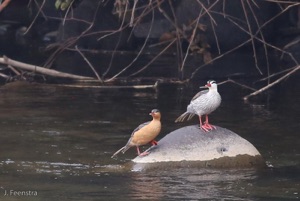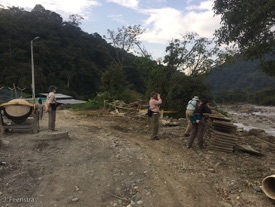Covering an enormous elevation range, approximately 3000 meters, this tour was like a roller-coaster ride up and down the Amazon slope of the Andes. In the space of a few days (and only about 25km as the quetzal flies) we saw thin-air specialties like Rufous-bellied Seedsnipe plus classic lowland birds like Paradise Tanagers and Gould’s Jewelfronts. Great mammals also bracketed the tour: a Spectacled Bear from the highway on our first day, and an Andean Fox along a highland road on our way back. We stayed at some of Ecuador’s best eco-lodges that made birding about as easy as rolling out of bed.
We started the tour driving up to the continental divide and right away things were showing potential. From the highway we spotted a Spectacled Bear digging around on a near-vertical hillside. A contender for “bird” of the trip. From the high pass we traveled further up, to nearly 15000 feet, across the high paramo.
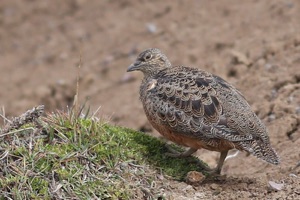
We found some of the specialties therein such as Tawny Antpitta (the only “easy” antpitta), Andean Tit-Spinetail, and Ecuadorian Hillstar. The real star, though, and a lot of work, was the pair of Rufous-bellied Seedsnipes shuffling around at the very top. Naturally, we had to hike around a while breathless in the wind and fog before we found them from the road just below the parking area. All good, though. From there we began our descent, first stopping at Guango Lodge for lunch, some hummingbirds, and a nice mixed flock that included Rufous-breasted Flycatcher, a few Pearled Treerunners, and Black-capped Hemispingus. As we continued to descend in elevation, we made a couple more stops for Red-breasted Blackbird and White-capped Dippers, and found ourselves that evening at Cabanas San Isidro, where we’d be for the next two days.
The unclassified Black-banded “San Isidro” Owl was great to see perched near the lights each night, but there was more. Some of our first birds outside the lodge on our first morning were a pair of Crested
Quetzals. A pair of Masked Trogons, not to be outdone, were perched nearby. We also had great luck with flycatchers, finding both Marble-faced and Variegated Bristle-Tyrants, Handsome Flycatcher, and the bright and diminutive Rufous-crowned Tody-Flycatcher. Tanagers weren’t too abundant, but looking down off the lodge deck at a couple of Blue-winged Mountain-Tanagers as they picked off berries from the tree was pretty cool. At the Rio Cosanga, in town a few kilometers from the lodge, we had a family of Torrent Ducks
paddling around in the whitewater.
In one of the next canyons over from the lodge we walked a quite road along a river and through some beautiful cloud forest. Though we struggled with flocks, we had great luck in finding a pair of striking White-rumped Hawks building a nest. “Big” birds were apparently our hot streak and at one point we were watching two Andean Motmots and a female Andean
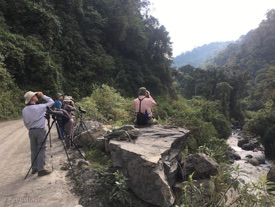
Cock-of-the-rock at the same time. We had a fantastic send-off lunch at San Isidro before we began our continued descent into foothill rainforest. We stopped for a quick look at big orange Cliff Flycatchers over an old quarry then took a longer break to bird the gardens at a restaurant near the Rio Hollín. In addition to a couple of White-capped Dippers in the river, a noisy troop of Violaceous Jays, and a different noisy troop of Many-banded Araçaris, the hummingbirds were going off. There were several White-tailed Hillstars battling with Many-spotted Hummingbirds and a Black-throated Brilliant. At the verbena patch the almost comical little Wire-crested Thorntail was pointy at both ends. Hummingbird rarities included a tiny Gorgeted Woodstar and a bright Rufous-throated Sapphire. We eventually pulled ourselves away and finished the drive to Wildsumaco Lodge situated on the south slope of the Sumaco volcano and our base to explore the Amazon foothill rainforest.
For an entire day we barely used our vehicle. We started from the lodge parking lot. The light had attracted moths overnight and, come daylight, those moths attracted a pair of Plain Antvireos, a Black-billed Treehunter, an Ornate Flycatcher, and an American Redstart. Like many lodges now, Wildsumaco has an antpitta feeding station, and this one casts a wide net attracting various stuff in addition to a target antpitta.
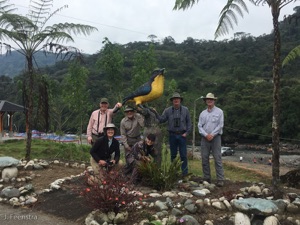
Sure, a pair of Ochre-breasted Antpittas and a Plain-backed Antpitta came in to eat, but so also did a Gray-cheeked Thrush and Northern White-crowned Tapaculo: four typically invisible forest birds from one bench. We spent the rest of the day working the road through the reserve. Red-headed Barbets, Gilded Barbets, and Paradise Tanagers were in the mixed flocks and exploding with color. Other things, like Olive-chested Flycatcher and Sooty-headed Tyrannulet, not so much. Truly spectacular, bright and bizarre, were a pair of Golden-collared Toucanets that we watched eating and jumping around a cecropia tree. We finished the day, after another great meal, listening to three species of owl: Vermiculated Screech-Owl, Rufescent Screech-Owl, and Band-bellied Owl. They never quite cooperated visually, but we enjoyed their talking nonetheless.
Then it was time for going back up. But not quite yet. We started doing some deep, dark forest birding. And, as is often typical for such we heard a lot and got fleeting glimpses at some like Spot-backed and Common Scale-backed Antbirds. Then we really did start back up hill. It rained most of the way so we didn’t do too much birding until we got past the clouds and walked a quiet road bordering some forest and pasture.
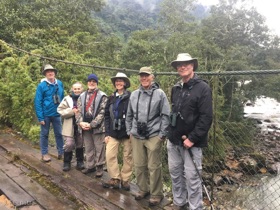
In great light we had prolonged views of perched Saffron-crowned and Black-capped Tanagers, and a pair of Speckle-faced Parrots. A Roadside Hawk in an apparent standoff for a nice perch eventually got bullied out by the persistent parrots. After a stop for ice cream we returned to Guango Lodge, this time for the night, but not before we walked down to the rickety old bridge and there watched a pair of Torrent Ducks chasing each other around, seemingly effortlessly navigating the raging whitewater. We ended with a great dinner and hot water bottles to take the chill off the sheets.
Our last day was cold! We started around Guango Lodge watching the Turquoise Jays pick moths off from around the lights. It was raining, so we went up in elevation to see if we could get above the weather. At 3700m in Cayambe-Coca National Park it worked for a little while and we got to see a Scarlet-bellied Mountain-Tanager and multiple Viridian Metaltails. We also had our second great mammal of the trip, an Andean Fox. A bear on the first day, a fox on the last. Then the rain caught back up with us. This time we retreated over the pass to the inter-Andean slope. We were successful here staying ahead of the bad weather and enjoyed a wonderful walk through treeline scrub while watching Black-chested Buzzard-Eagles soar overhead. We even got surprisingly good looks at a Paramo Tapaculo. We ended the tour watching Shining Sunbeams, Black Flowerpiercers, and a Black-billed Shrike-Tyrant while looking out over Quito, the sun shining down through the clouds. The finale of another great time in the mountains.


